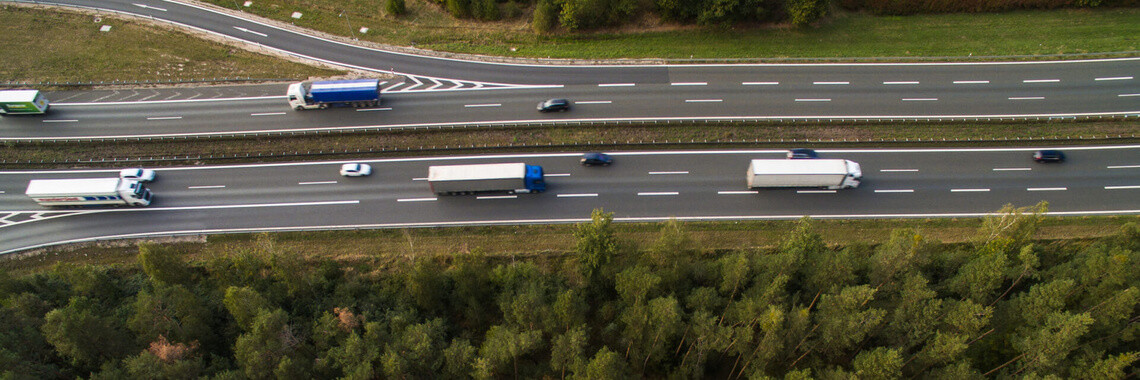
fuel efficient driving key tips for truck driver
As fleets across the world contend with inflation and rising fuel costs eco-driving is quickly becoming the new norm. This driving style requires drivers to adopt behaviors that lower fuel consumption ౼ which in turn saves money, reduces carbon emissions and vehicle wear, and boosts driver safety!
Join us as we travel to Poland for some expert advice on the real life, on-the-road benefits of eco-driving. What does fuel efficient driving achieve and which driving techniques can help you save fuel?
Tomasz Leki, CEO of Poland’s Transport Krajowy i Międzynarodowy company (National and International) and his drivers share their thoughts in the videos below:

tomasz leki ceo of transport krajowy i międzynarodowy gives us tips to adopt eco friendly driving
Tomasz Leki, CEO of Transport Krajowy i Międzynarodowy
Why is it important to train truck drivers in fuel efficient techniques?
Eco-driving is a set of practices and behaviors that refine the overall driving style, emphasising control and moderation. These practices, outlined in our podcast, can reduce fuel consumption by as much as 25%1 and reduce the risk of accidents by as much as 15%2 ౼ making it good for the planet, driver safety and a fleet’s bottom line.
To watch this video, you'll have to accept some cookies from Youtube platform. Just click on the button below to open the cookie module.
Accept youtube cookiesIn this video, Tomasz Leki explains that he looks at fuel efficient driving as a fun challenge to motivate himself and his fleet. “I have always enjoyed analysis, and that's what interests me the most in eco-driving,” he says. “I personally like improving my results and developing my skills as a driver.” He outlines three key eco-driving elements:
- • minimising engine idling time
- • avoiding abrupt acceleration
- • avoiding sudden braking as much as possible
“The most crucial aspect is maintaining driver focus. The driver is the most important piece in this puzzle,” he adds.
According to Leki’s estimates, practicing eco-driving can save approximately two litres of fuel per 100 kilometres, which totals around 20,000 litres annually. For a fleet with 10 vehicles, that translates to approximately 140,000 Polish złotys, or €32,417, at current fuel prices!
Given the important role that drivers play in lowering a fleet’s overall fuel consumption, Leki says that driver training is key. Afterall, a well trained driver experiences less stress, is more efficient and is better equipped to find solutions to problems that may arise.
Fuel efficient driving best practices you need to adopt
Drivers and fleet managers often find themselves wondering which driving technique can save fuel? Not to worry, fuel efficient driving is very straightforward once you break it down. For starters, ease up on the accelerator ౼ the more you accelerate, the more you will need to brake and the more fuel you will consume3. It’s also important to swift gears at the right moment; that means listening to your engine and swifting up before it starts revving too loudly.
To watch this video, you'll have to accept some cookies from Youtube platform. Just click on the button below to open the cookie module.
Accept youtube cookies“The most significant external factors influencing ecodriving broadly are traffic conditions and weather conditions. However, it should be noted that by applying [fuel efficient driving] practices, better results can be achieved in any conditions compared to not implementing them at all,” says Tomasz Leki.
He also recommends GPS-connected telematics to implement and monitor efficient driving techniques. He adds: “For me, tyre selection is crucial, and the most important aspect is maintaining the right compromise between energy efficiency and durability, as well as available mileage.”
Michelin knows that tyre maintenance is another crucial element in fuel efficient driving. For example, underinflated tyres can cause excessive fuel consumption. Specifically, for every 1.5 bar of under-inflation, a truck consumes 1% more fuel4 ౼ making regular tyre checks absolutely critical for safety, fuel consumption and a truck’s environmental impact as well.
What real life truck drivers think of eco-driving
To see how drivers themselves feel about eco-driving practices, we chatted with a few of the team at Transport Krajowy i Międzynarodowy.
To watch this video, you'll have to accept some cookies from Youtube platform. Just click on the button below to open the cookie module.
Accept youtube cookiesAccording to truck driver Pawel Leki, the biggest hurdle to implementing and encouraging fuel efficient driving is debunking the stereotype that eco-driving is not only slow, but also that it goes against the norm on the roads today. He insists: “Driving economically means driving safely, driving calmly, driving responsibly, and thanks to that, I can be more efficient, more aware of what I am doing.”
When drivers practice fuel efficient driving techniques, their overall driving experience is more relaxed and tranquil and prevents on-the-road stress from creeping into their everyday lives. “I simply enjoy driving,” says Piotr Czypionka, a freight forwarder with Transport Krajowy i Międzynarodowy. “The fact that I can drive economically gives me peace of mind, a sense of control and provides safety on the road in all manoeuvres I make.”
In this video, Pawel Leki shares a practical example of how he anticipates a roundabout ahead of time. “I start [the braking process] early enough to smoothly approach it, decelerate the truck, loaded with an engine retarder.” If done correctly and efficiently, drivers can navigate the entire roundabout without even using their brake, simply by anticipating the turns and downshifting at the right moment.
When it comes to reducing your fleet’s fuel consumption and shrinking your carbon footprint, fuel efficient driving techniques are a great place to start. If you’re still hesitant ౼ wondering what does fuel-efficient driving achieve? ౼ be sure to check out our video interviews with Transport Krajowy i Międzynarodowy. For years, they have put their trust in Michelin and our tyres to help improve fuel efficiency. Check out how they apply these strategies in their everyday lives!
FAQ
What is fuel efficiency?
Fuel efficiency is the distance that a vehicle can travel using a specific amount of fuel. When you increase the distance you’re able to drive using the same amount of fuel, that means you have boosted your fuel efficiency! This is great news because you are not only saving fuel, but you’re also reducing carbon emissions and improving driver safety!
What affects a vehicle’s fuel efficiency?
Several factors can impact your truck’s fuel efficiency, from the type of cargo you haul to the type of tyres you choose. On top of these critical aspects, driver behavior ౼ including high speed driving, inefficient gear shifting, excessive engine idling, etc. ౼ can hugely impact fuel efficiency.
What are some efficient driving tips?
-
Challenge yourself to drive smoothly ౼ that means avoiding abrupt acceleration and sudden braking
-
Minimise idling time by turning off your engine when possible
-
Encourage yourself, and your team of drivers, to be a focused, present and alert driver
-
Prioritise tyre selection and maintenance
(1) https://auto.economictimes.indiatimes.com/news/how-eco-driving-can-cut-up-to-25-off-your-fuel-bill/59264641
(2) https://www.praxedo.com/our-blog/field-service-management-why-maintenance-technicians-need-to-learn-eco-driving/#:~:text=Smoother%2C%20more%20proactive%20driving%20helps,
mindful%20in%20their%20driving%20tactics.
(3) https://money.howstuffworks.com/personal-finance/budgeting/how-to-drive-economically7.htm
(4) Internal study carried out by Michelin valid for 9 bar pressure

gettyimages 930571046
car going fast on a road by night







